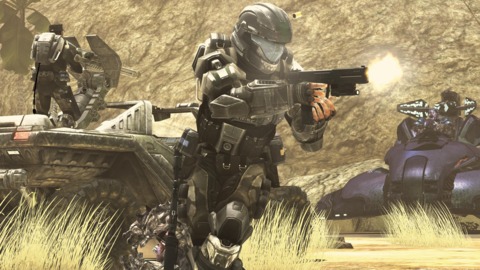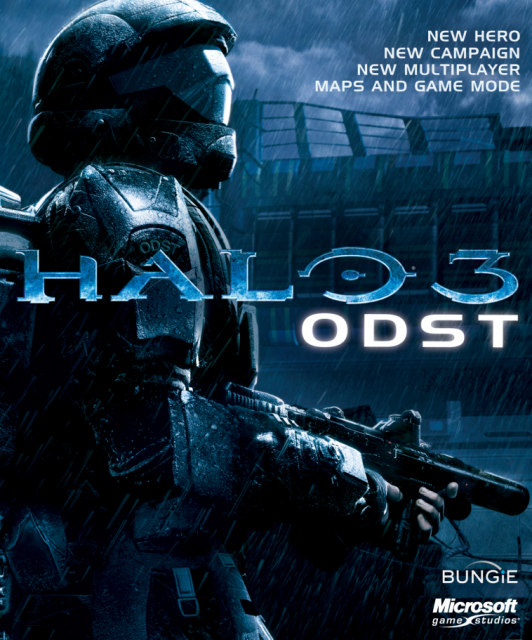Halo 3: ODST is short, but sweet
In the interest of full disclosure, I must admit that I’m somewhat of a Halo nerd. I’ve read the books and the comics, spent hours on end investigating the I Love Bees ARG and searching for skulls with fellow Dibcaster Jeremy, and of course, I’ve played all of the games countless times over. Either I’m the best person to review this game, or the absolute worst. I’ll let you decide that after you’re done reading.
Despite this being a first-person shooter with the word “Halo” on the box, the Master Chief is nowhere in sight. In Halo 3: ODST, you play as “The Rookie”, a nameless, faceless, and voiceless new recruit to the Orbital Drop Shock Troopers - ODSTs for short. Running concurrently with the events of Halo 2 and leading into the start of Halo 3, the games begins with you and your team being dropped into the African mega-city of New Mombasa shortly after the Covenant have arrived. As you drop pod is hurling towards the city, a Covenant warship makes a slipspace jump, and the resulting shockwave causes your pod to be thrown of course, separating you from the rest of your team. Being knocked unconscious upon landing, you awaken several hours later after darkness has fallen over the city, blow the door off your drop pod, and begin searching for clues to the whereabouts of your four squad mates - Buck, Romeo, Dutch, and Mickey - and Captain Dare, the ONI officer in charge of the team’s mission.
Blowing off the door to your pod and dropping 20-odd feet to the street below, you’re introduced to the biggest difference between ODST and its predecessors - they’re far less resilient than Spartans. They take damage from big falls and aren’t decked out in state-of-the-art super armor or protected by energy shields. Overshields are now replaced by stamina, and while the concept is the same, your stamina bar refills much slower than the Master Chiefs shields. Once your stamina is depleted, you’re simply down to your health bar, and once that’s gone, so are you. It’s a system that should be familiar to any Halo fan - as it’s nearly identical to the one seen in the series’ first entry, Combat Evolved. ODSTs move a little slower and jump a little less high than their Spartan counterparts, and you won’t see them duel-wielding weapons or hijacking any vehicles bigger than a Brute Chopper, although they can board a Wraith and chuck a grenade inside the cockpit just fine. These minor but nonetheless significant changes add up to a far more strategically paced game. You won’t be able to charge into a squad of Brutes and Grunts and expect to survive. Instead, you’ll have to approach each encounter with the Covenant with extreme caution, plotting a course of attack before rushing into battle. Your two default weapons - a silenced SMG and a silenced version of the original Halo magnum pistol - are both new to the series and point to the games shift in focus to more stealth-oriented gameplay.
The typical Halo HUD has also seen some changes. Gone is the motion censor, replaced by a night vision and targeting system called VISR. When activated, VISR provides additional light in low-light situations, which is particularly useful considering just about half of the game takes place at night. It also highlights enemies and allies with red and green outlines, respectively. VISR also acts as a virtual database of sorts, displaying mission objectives and a pretty nifty map of New Mombasa, as well as compiling any and all com data you may find during the game.
Most of your playtime as the Rookie is spent in New Mombasa at night, six hours after your team dropped in. The city is a semi-open world, with multiple options available on how to reach your destination. In many situations, the open nature of game allows you to avoid the many Covenant squads patrolling the city, should you choose to do so. The city itself drips with atmosphere. Overturned cars and debris litter the city streets. Graffiti scrawls can be seen on buildings, proclaiming “UNSC = LIARS” and reminding people to “Remember Reach”. New Mombasa is essentially a hub world to facilitate the game’s missions. Each mission begins by finding a certain clue to one of your missing teammates. When that item is located, you’re thrust into a flashback of the events that occurred during the six hours you spent unconscious in your pod. Each of these flashbacks puts you in the boots of one your squad mates, and retains the linear structure of a typical Halo game. After the mission concludes, you become the Rookie once more, in pitch dark New Mombasa, off to find the next clue. The dichotomy of these moments can be breathtaking, being thrust from an intense daylight battle back to the quiet and desolate city and oftentimes standing on or near the very spot in which the flashback mission ended.
On your travels through the city, you may also come across several scattered audio logs featuring a young woman named Sadie. There are 30 logs in all, all of which that tie into the main story of ODST, as well as chronicling Sadie’s journey during the attack on New Mombasa and giving you more background on the Superintendent, the AI that essentially runs the city. These logs are a compelling and detailed piece of Halo lore, and go far beyond the mere “collectible” that they may first appear to be on the surface, and a terrific addition to the overall ODST experience.
While I already touched on the game’s terrific atmosphere, I neglected to mention what is perhaps the most important

piece of its tone: Marty O’Donnell’s incredible score. O’Donnell has always done solid work for the Halo franchise, but perhaps none more moving than the score he has put together for ODST. Every piece crafted for ODST has a sense of weariness and sorrow that really conveys the overall feel of the game. The Covenant have found Earth, New Mombasa is in ruins and these six soldiers are just hoping to make it off the planet alive. While the music is especially effective during your time spent exploring New Mombasa as the Rookie, even the more intense battle marches of the flashback missions have just that hint of somberness.
Also worth noting from in the sound department is the wonderful cast of actors assembled for Halo 3: ODST. The cast is, without a doubt, a geek’s dream. Nathan Fillion of Firefly fame steps into the role of Sgt. Edward Buck, leader of your ODST squad, who brings the sort of smart-ass swagger you’d expect from one of his characters. Joining Fillion are fellow Firefly stars Alan Tudyk and Adam Baldwin, who provide the voices for squad members Mickey and Dutch, respectively. ONI agent Veronica Dare is played by Battlestar Galactica star Tricia Helfer, who does an great job despite being the weakest of the main voice cast. Both Helfer and Fillion provided their likeness as well as their voices to the characters. Rounding out the voice cast is the voice of Nathan Drake himself, Nolan North, who lends his pipes to the ODST known as Romeo.
Even though ODST is running on the same graphics engine that brought Halo 3 to life two years ago, it still looks very good, and in many spots, much better than its 2007 counterpart. These improvements are most notable when you’re progressing through New Mombasa at night, with burning cars, police lights, and the flickering lights of the Superintendent’s various signage casting a subtle glow over the dark city.
Being a Halo game, you’d expect there to be a multiplayer component, on that Bungie delivered. Sort of. Forgoing the traditional versus multiplayer we’ve all come to love (or loathe) since Combat Evolved, Bungie has instead included a 4-player cooperative mode called Firefight. Similar to Horde in Gears of War 2, Firefight pits you and three friends against endless waves of Covenant forces, each wave getting increasingly more difficult. Between rounds, different “skulls” will activate, causing the enemies to throw more grenades or have extra health. It is far more challenging and much less limited than Horde, and might I add much more addicting. You and three friends can also tackle the single-player campaign if you’d like, but the unfortunate side effect to the game’s amazing atmosphere is that its campaign will likely be more enjoyable when played alone. While ODST itself has no versus component, Bungie has included a standalone Halo 3 multiplayer disc with ODST. This disc includes all of the downloadable maps for Halo 3 that are available on the Xbox Live Marketplace, as well as three brand new maps - including a remake of fan favorite Midship from Halo 2 - that are only available (as of right now) with Halo 3: ODST. This second disc is a nice addition, even if it does seem like an attempt to justify the $60 price tag on a game that was first introduced as a simple “expansion” to Halo 3.
ODST has its flaws of course, but they are few and far between. There are some nagging AI issues, most notably enemies can sometimes become stuck perpetually running into the side of a building or rock, as if they became confused during their pursuit of you. The campaign is shorter than the other games in the series, and most players will complete the campaign in under 8 hours, although playing on the Legendary difficulty and searching for the audio logs will likely bump that up to a solid 10. Even with the shorter campaign length I can honestly say that ODST features far and away the best Halo campaign since Combat Evolved. If you don’t like Halo games, I doubt ODST will do anything to change your mind. However if you’re a fan of the series, there’s no reason ODST shouldn’t get a spot on your games shelf.
